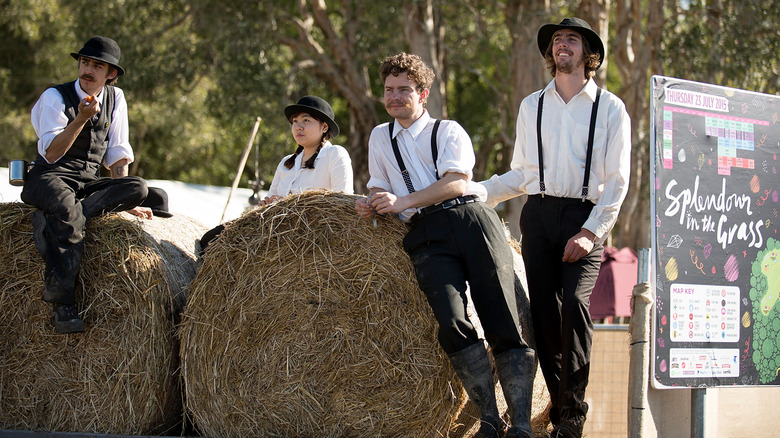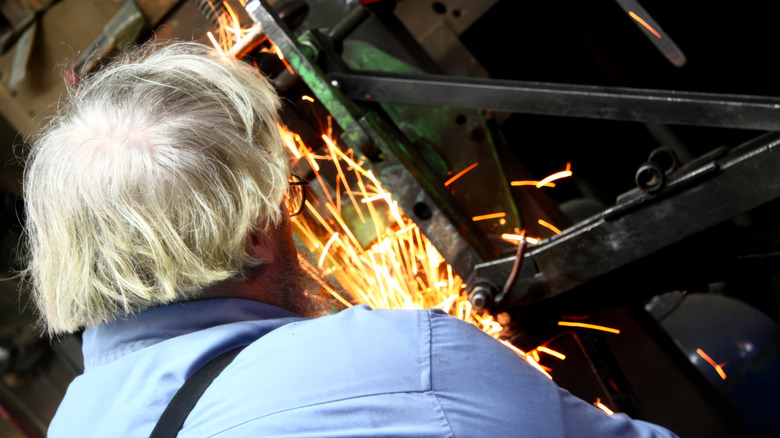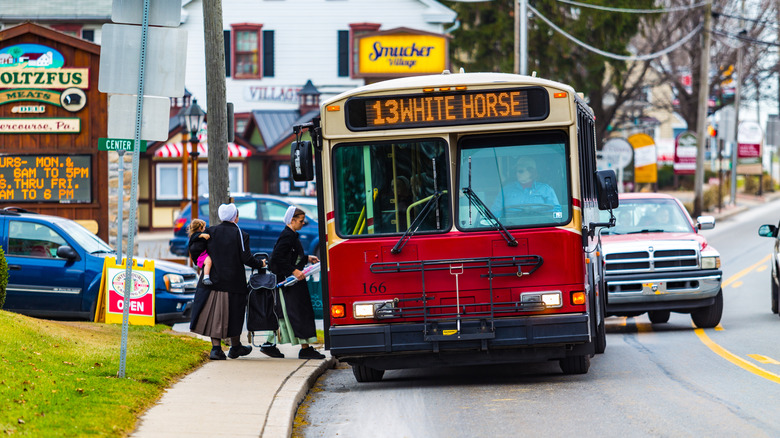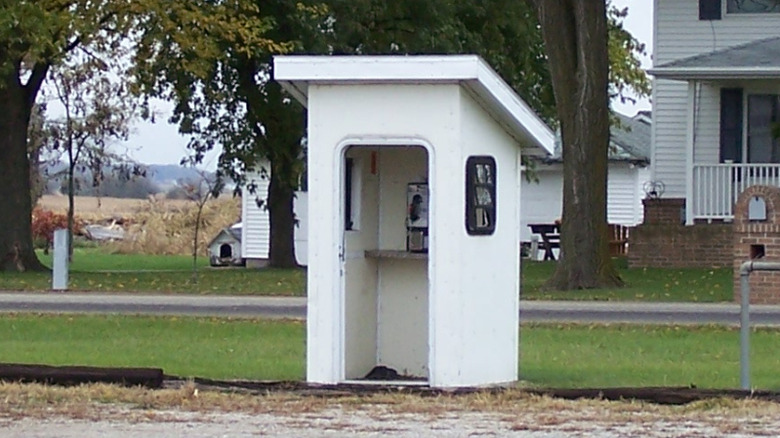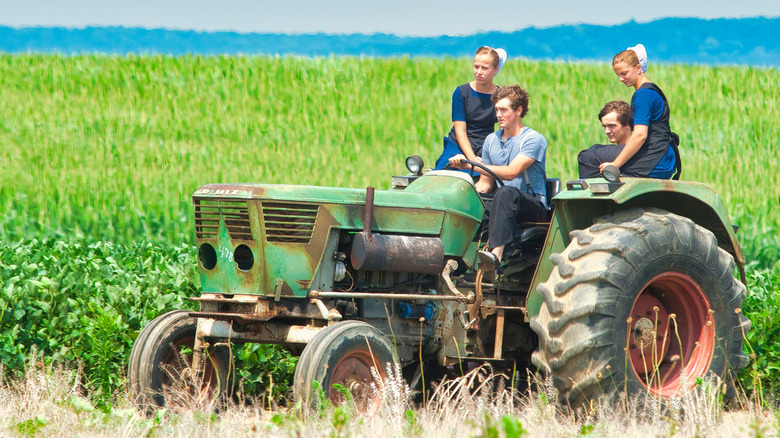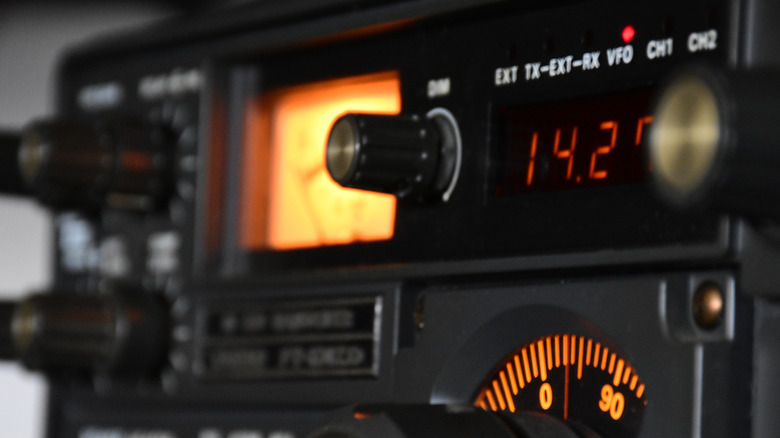10 Pieces Of Tech You Might Not Realize The Amish Can Use
The Amish are a curiosity in the modern world. Whereas most people use if not rely on technology for their daily lives, the Amish keep their use of technology to a minimum and do just fine without it. Heck, while many non-Amish struggle to lose weight and need the assistance of high tech gadgets to do so, the Amish stay healthy into their old age due to their active lifestyles, which can be attributed to their relationship with modern tech. However, don't believe everything you hear about the Amish and their views of technology.
Contrary to popular belief, the Amish are not luddites. You will probably never find a member of an Amish community using Android apps as a fitness tracker or security camera –– or using an Android phone at all –– but the Amish do not simply reject all modern technology. Certain Amish communities are willing to embrace specific technologies not because they're useful for the individual but because they can improve life within their enclave. Such distinctions determine which gadgets the Amish will adopt, and we're here to go over a few of them. Here are some of the pieces of technology the Amish are allowed to use.
Types of Amish people
On the surface, the Amish way of life is a deeply conservative type of Christianity known as Anabaptist that espouses and enforces a very specific and traditional way of living. But when you dig deeper, you will find that each Amish community has its own rules and views regarding the world and technology. Assuming all Amish communities are the same is like assuming Catholic and Protestant beliefs are alike.
Currently, you can find over forty Amish "affiliations" across the United States. They all share some characteristics, including preferring simple and plain clothes, living in rural isolation, and aiming towards self-sufficiency. However, due to their self-imposed isolation, the Amish are far from unified in their beliefs, despite shared core tenets.
Every Amish community revolves around a central church and its "Ordnung" (i.e., rules and regulations). It was once widely believed that the Amish were divided into four affiliations: Swartzentruber, Andy Weaver, New Order, and Old Order. However, this list has expanded to recognize denominations such as Lancaster, Holmes, Nappanee, and several variations of Swiss. What distinguishes them? It all comes down to their traditions and approach to technology. For instance, New Order Amish groups are more accepting of technology, whereas the Swartzentruber Amish forgo almost all technology. They don't even place orange safety triangles on their buggies to denote them as Slow Moving Vehicles. Despite any surface similarities, no two Amish groups see eye to eye, especially when it comes to modern technology.
Plumbing
The Amish prefer to do all their work with their own hands — no farming robots with weed-killing lasers for them. However, this means that the Amish tend to get very dirty, which raises the question of how they clean themselves. The answer is determined by their community's views on technology and whether they think bathrooms are too "worldly."
Wtih regard to personal hygiene, the Amish can be divided into two categories: Those who have bathrooms, and those who don't. Generally speaking, those with bathrooms are likely to have running water thanks to the miracles of modern plumbing. This lets them take showers and even install toilets in their houses. However, the more conservative Amish groups usually take baths or sponge baths and rely on hand pumps to ferry water from wells. When nature calls, they run to an outhouse.
With the prospect of showers comes another question: Can Amish people take hot showers, or must they make do with cold water? Well, not even the most conservative of Amish communities force their members to take cold showers. The technology-lenient Amish heat their water using technology connected to solar panels, and the moderate ones rely on natural gases. Meanwhile, the most conservative just heat up their bath water, and by extension their homes, with wood fire stoves. They need a constant supply of lumber, but at least they'll never go cold.
Propane
The Amish are nothing if not sticklers for their own rules. This is why you will never find an electric stove in an Amish home. However, there are big differences between electric and gas stoves and some Amish communities accept natural gas in their homes.
The more "liberal"-minded Amish embrace the use of propane for a variety of uses, not just heating homes and water. One of the most obvious examples is cooking. If an Amish community allows for propane, you can expect to find gas ranges in their kitchens. However, as anyone who has ever used a gas range knows, propane is useless without an igniting spark. This doesn't pose an issue to Amish families who use gas stoves. While most modern models have electric-powered igniters, the Amish use ranges with battery-powered igniters. Yes, technically batteries supply electricity, but since they let Amish users stay off power grids, they don't break most Ordnungs.
The Amish use of propane and other gases can extend to other devices within communities. For instance, they can use gas grills to cook outside. And yes, portable propane grills also count. But that's not all. As surprising as it might sound, tons of other devices can run off propane or even kerosene, including shop tools and refrigeration units (more on those later). So long as an Ordnung doesn't forbid the use of propane, these devices are all fair game for an Amish community.
Guns
Firearms are a contentious topic in the United States. On one hand, a new mass shooting takes place seemingly every other day, but on the other hand, many farmers need guns to protect their livestock from predators. The Amish have a more straightforward relationship with guns thanks to their traditions.
As Amish people are deeply religious, they follow the teachings of the Bible to a tee, especially when it comes to violence. Essentially, Amish are pacifists, but they have no qualms against owning and using guns. To them, a firearm is nothing more than a tool used to hunt animals for food and fend off predators and vermin who eat their livestock and munch on their crops. The Amish are so dedicated to peace that if someone tries to rob an Amish community, its members will not take defensive action, but if a pack of coyotes attack an Amish farm's sheep, the men won't hesitate to pull out their hunting rifles.
The Amish's view of guns isn't without its hiccups. While most Amish weapons are handed down and well-maintained, if they need to buy a new one, they tend to run into a little issue with photo ID requirements. All Amish people have an ingrained religious objection to any form of "graven image." This is why Amish dolls don't have faces. This belief extends to photographs. However, without a photo ID, most gun sellers won't do business with them. In 2015, an Amish man sued the US government over this issue, claiming that it violated his religious rights.
Motorized and shop tools
You can find plenty of products built by Amish artisans if you know where to look. They are generally high quality, and unlike mass-produced alternatives, they are constructed by hand. Well, usually — it depends on the specific Amish denomination and their views on technology.
Nine times out of ten, if an Amish worker can produce something with their bare hands or a hand-powered tool, they will do so. This also applies to tools that are strapped to horses, such as plows. However, if a tool doesn't run on electricity and produces a result you can't replicate with just your hands, then more progressive Amish communities might use them. Examples include propane-powered forklifts and hydraulic-powered saws. And as with gas ranges, battery-powered items are an odd exception to the "no electricity" rule because they grant Amish users independence from the outside world.
Given the Amish's occasional acceptance of battery-powered tools, one might wonder how they keep these items topped up. Surprisingly, they don't have to frequently visit the hardware store. Instead, Amish people who embrace batteries use solar power to charge them, but that's not all. Amish communities with solar power installations also use some of the juice collected from the sun to power electric fences.
Cars and public transportation
When you think of Amish people, you probably envision them riding in a horse-drawn buggy. To be fair, most Amish use this form of transportation because they're not allowed to own cars. However, that particular word, "own," opens up a world of complications regarding how the Amish view cars.
All Amish people are forbidden from owning cars, but some denominations do not view riding with someone else in their car in the same light. To these liberal-ish Amish denominations, carpooling for business or social excursions is perfectly acceptable, and this logic extends to public transportation such as trains and buses. However, when it comes to airplanes, disagreements form among even the most progressive of Amish communities. Some groups, such as those in Pennsylvania's Lancaster County, will refuse to fly in planes, but the Ohio Amish will buy airline tickets if they need to go somewhere in an emergency. But as with cars, owning a plane is still forbidden.
As previously stated, while Amish men can't own cars, they are more than welcome to own horse-drawn buggies. These serve as their primary mode of transportation when they need to go somewhere that is too far to walk. For the most part, Amish buggies are as low-tech as possible, but some Amish folk upgrade them with modern technologies, namely battery-powered lights and turn signals. These aren't intended to make life easier but to make traveling on the road safer, especially at night. There's nothing worldly about letting other drivers know you're coming around a bend when it's dark.
Phones
Amish communities are self-contained and self-sufficient. Almost everything they will ever need is within walking distance. Who needs a phone when you can just meet in person? However, there is always room for extenuating circumstances.
Some Amish denominations view phones the same way they view cars; the more technology-accepting communities let members use phones but not own phones. Instead of placing telephones in the house, they are stored in communal locations such as telephone booths. However, if an Amish person owns a store, they will place a telephone in their office to take business calls.
To be fair, progressive Amish views on phones makes sense since they are used as a necessity and are kept out of arm's reach to prevent them from being too much of a distraction. Given these Ordnung-based regulations, one might assume that cellphones and especially smartphones are outright forbidden. Surprisingly, this isn't necessarily true. Depending on the Ordnung, cellphone use might be limited to emergencies, or they might be allowed without restriction so long as the user is in private. And, whether someone can use a smartphone or is restricted to elementary cellphones is up to each community and its rules. Just goes to show you can't lump all Amish people into one group.
Tractors
As previously established, many Amish can use cars, trains, planes, and buses in an emergency or when a horse-drawn buggy won't suffice — they just can't own a car. However, they can sometimes own farming equipment and use it as a makeshift car.
While the traditionally-minded Amish communities till and plow soil with horse-drawn tools, the most open-minded ones, such as New Order, accept the use of tractors. Mostly, anyway. Some Amish denominations have provisions attached to their use of tractors, such as prohibiting rubber tires, but so long as these rules are followed, members of the community have somewhat unrestricted access.
Since tractors are designed primarily for farm use, Amish views regarding the vehicle can be more lax when compared to their views of cars. If a community permits tractor use, it probably also allows tractor ownership. More importantly, Amish people who own tractors use them in lieu of cars and even horse-drawn buggies. After all, tractors are faster and pull more weight despite having low horsepower. Plus, when tractors run low on fuel, owners only need a few minutes to fill up the tank. Horses, meanwhile, need a good long while to eat, drink, and rest, which makes tractors more efficient on the road and the field. Still, given all the different Ordnungs, don't expect more traditional Amish communities to adopt tractors anytime soon.
Household appliances
When an Amish community paints its rules regarding technology, it tends to use as broad a brush as possible. If tools are forbidden due to their reliance on electricity, then other items that use the same power source are likewise banned. But if farming equipment can run on other, allowable sources of energy, then anything else that uses that particular fuel is allowed.
You might be surprised to learn this, but some companies produce propane-powered refrigerators, and as we already established, some Amish communities embrace propane and other natural gases, as well as the technologies they power. Maytag used to make wringer washers that ran on gasoline, and while the company doesn't sell them anymore, you can find them in Amish towns with more lenient views on technology. This logic also applies to fuels such as diesel, which some Amish communities do not oppose.
Depending on an individual Amish community's Ordnung, members might be more concerned with staying off the grid than with using modern technology. We already have discussed solar panels, but it's not unheard of for Amish people to use generators to power devices. Some Amish houses even use LED-powered lights since they are more energy and cost-effective than incandescents – so long as they can run off a generator or a solar panel, that is. More often than not, the Amish rely on oil lamps and candles.
Computers and the internet
While you can buy Amish-built goods in brick and mortar stores, you can also find plenty online. This raises the question of how they got online to begin with, and the answer is, quite obviously, computers. But that raises another question: Don't the Amish have religious qualms against using computers? The answer to that question also lies in their religious doctrines.
Quite a few Amish people who make and sell their products view computers as just another tool. Thanks to computers and the internet, Amish artisans can sell their products across the globe. Plus, computers can be indispensable for bookkeeping and tracking finances, but much like how Ordnungs differ from community to community, no two Amish computer owners use the same programs. If, say, a business owner is good with numbers, it is their religious duty to calculate finances with a pen and paper, no matter how much easier using Quickbooks would be.
In a somewhat ironic twist, Amish business owners are more likely to own computers than they are to use them. How does this work? By contracting computer work out to a local non-Amish person. Depending on their skillset, this individual could do everything from keeping the computer properly patched and updated to producing designs with the aid of programs. Ultimately, a computer's place in an Amish business comes down to one question: Will it hurt the Amish way of life? And there is never any one right answer.
Entertainment
The Amish look at entertainment the same way they look at cars: Why play video games when a nice, wholesome book will suffice? But like their view on cars, the Amish separate the concept of using an item from the concept of owning one.
Regardless of their views on technology, all Amish communities agree that entertainment should be as simple as possible. Leisure tends towards activities such as fishing, volleyball, and ice hockey when the weather permits. You will almost never find a radio or a TV in an Amish household. This is both due to their reliance on electricity and the general Amish opinion on modern entertainment. Per the BBC, Professor Donald B. Kraybill, who is considered an expert on Anabaptist faiths, relayed the common Amish belief that "television is the sewer line that connects you directly to the cesspool of Hollywood." However, these rules are only hard and fast within the community.
Depending on who you ask, some Amish travelers might listen to radio or even watch television, but only on a "when in Rome" basis. They might join in on the fun when someone else is listening to a radio or watching TV, but they wouldn't be the one to turn it on. It's hard to keep tabs on the Amish and their exact relationship with radios thanks to Mennonites, another Anabaptist denomination that was once part of the same Protestant group. They share some ideals with the Amish, such as dressing modestly, but Mennonites more readily accept modern technology and can own ham radios and listen to Christian contemporary and worship music. Still, if and when the Amish listen to radios, they probably take a similar approach and avoid anything like the popular tech enthusiast podcasts you love.

